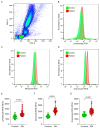Fibrinogen Structural Changes and Their Potential Role in Endometriosis-Related Thrombosis
- PMID: 39765785
- PMCID: PMC11673276
- DOI: 10.3390/antiox13121456
Fibrinogen Structural Changes and Their Potential Role in Endometriosis-Related Thrombosis
Abstract
Endometriosis (EM), a chronic inflammatory condition predominantly affecting women of reproductive age, has been linked to an elevated risk of thrombosis, though its underlying molecular mechanisms remain incompletely understood. In this case-control study, involving 71 EM patients and 71 matched controls, we explored the structural and functional changes in fibrinogen and their potential role in thrombosis. Key oxidative stress markers, such as reactive oxygen species (ROS) levels in blood lymphocytes, monocytes, and granulocytes, along with plasma lipid peroxidation markers and total antioxidant capacity, were measured. Fibrinogen structure was examined using circular dichroism spectroscopy and intrinsic fluorescence, while functional properties were evaluated by analyzing thrombin-mediated polymerization and plasmin-induced lysis. Compared to controls, EM patients exhibited elevated ROS production and systemic oxidative stress, leading to notable fibrinogen oxidation and structural alterations. These changes were associated with impaired fibrin polymerization and enhanced resistance to plasmin-induced lysis, which are indicative of a pro-thrombotic state. These findings suggest that oxidative stress-driven fibrinogen modifications may contribute to the heightened thrombotic risk in women with EM, highlighting a potential therapeutic target to mitigate cardiovascular complications.
Keywords: endometriosis; fibrinogen; oxidative stress; thrombosis.
Conflict of interest statement
The authors declare no conflict of interest.
Figures





References
Grants and funding
LinkOut - more resources
Full Text Sources

